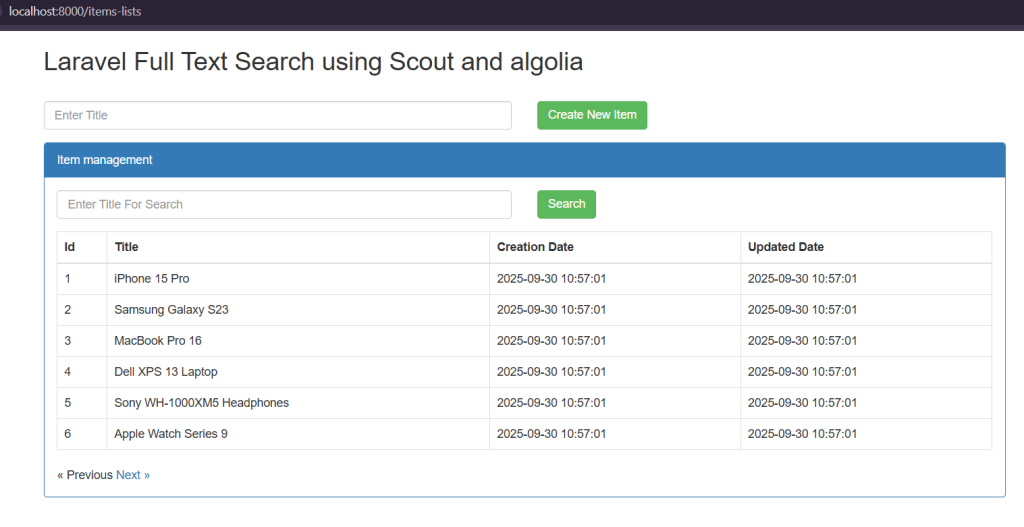
In this tutorial, I’ll Walk you through a step-by-step example of implementing full-text search in Laravel using Laravel Scout and Algolia.
Laravel provides us with the Scout package for adding a powerful full-text search layer on top of Eloquent models. Combined with Algolia, it makes search queries super-fast and efficient. If your application requires a smooth and accurate search functionality, this is the best way to go.
We’ll start from scratch and build a working search system in a fresh Laravel application.
Step 1: Install Laravel
If you don’t already have a Laravel project, create a fresh installation:
composer create-project --prefer-dist laravel/laravel algolia_exampleStep 2: Install Required Packages
We need two packages:
- laravel/scout – provides the search integration.
- algolia/algoliasearch-client-php – connects Scout to Algolia.
Install Scout:
composer require laravel/scoutPublish Scout’s config file:
php artisan vendor:publish --provider="Laravel\Scout\ScoutServiceProvider"Now enable queue support in your .env file:
SCOUT_QUEUE=trueNext, install the Algolia client:
composer require algolia/algoliasearch-client-phpStep 3: Configure Algolia
Create an account on Algolia.
After logging in, grab your Application ID and Admin API Key from the Algolia dashboard.
Add them to your .env file:
ALGOLIA_APP_ID=your-app-id
ALGOLIA_SECRET=your-admin-api-keyAlso, update config/scout.php to use Algolia as the driver:
'driver' => env('SCOUT_DRIVER', 'algolia'),Step 4: Create Items Table and Model
Generate a migration for an items table:
php artisan make:migration create_items_tableMigration example:
Schema::create('items', function (Blueprint $table) {
$table->increments('id');
$table->string('title');
$table->timestamps();
});Run migration:
php artisan migrateNow create the Item model:
php artisan make:model ItemAdd the Searchable trait and define searchable fields:
namespace App\Models;
use Illuminate\Database\Eloquent\Model;
use Laravel\Scout\Searchable;
class Item extends Model
{
use Searchable;
protected $fillable = ['title'];
public function searchableAs()
{
return 'items_index';
}
public function toSearchableArray()
{
return [
'id' => $this->id,
'title' => $this->title,
];
}
}Step 5: Add Routes
Open routes/web.php and add:
use App\Http\Controllers\ItemSearchController;
Route::get('items-lists', [ItemSearchController::class, 'index'])->name('items-lists');
Route::post('create-item', [ItemSearchController::class, 'create'])->name('create-item');Step 6: Create Controller
Generate a controller:
php artisan make:controller ItemSearchControllerInside ItemSearchController.php:
namespace App\Http\Controllers;
use Illuminate\Http\Request;
use App\Models\Item;
class ItemSearchController extends Controller
{
public function index(Request $request)
{
if ($request->has('titlesearch')) {
$searchTerm = $request->titlesearch;
try {
$items = Item::search($searchTerm)->paginate(6);
} catch (\Exception $e) {
// fallback to database query if Algolia fails
$items = Item::where('title', 'like', "%{$searchTerm}%")->paginate(6);
}
} else {
$items = Item::paginate(6);
}
return view('item-search', compact('items'));
}
public function create(Request $request)
{
$request->validate([
'title' => 'required'
]);
Item::create($request->all());
return back();
}
}Step 7: Create Blade View
Create a new file: resources/views/item-search.blade.php
<!DOCTYPE html>
<html>
<head>
<title>Laravel Scout Algolia Search Example</title>
<link rel="stylesheet" href="https://maxcdn.bootstrapcdn.com/bootstrap/3.3.7/css/bootstrap.min.css">
</head>
<body>
<div class="container">
<h2>Laravel Full Text Search using Scout & Algolia</h2>
{{-- Add New Item Form --}}
<form method="POST" action="{{ route('create-item') }}">
@csrf
<div class="row">
<div class="col-md-6">
<input type="text" name="title" class="form-control" placeholder="Enter Title" required>
</div>
<div class="col-md-6">
<button class="btn btn-success">Create New Item</button>
</div>
</div>
</form>
<br>
{{-- Search Form --}}
<form method="GET" action="{{ route('items-lists') }}">
<div class="row">
<div class="col-md-6">
<input type="text" name="titlesearch" class="form-control" placeholder="Search by Title">
</div>
<div class="col-md-6">
<button class="btn btn-primary">Search</button>
</div>
</div>
</form>
<br>
{{-- Item List --}}
<table class="table table-bordered">
<thead>
<tr>
<th>#</th>
<th>Title</th>
<th>Created</th>
<th>Updated</th>
</tr>
</thead>
<tbody>
@forelse($items as $index => $item)
<tr>
<td>{{ $index + 1 }}</td>
<td>{{ $item->title }}</td>
<td>{{ $item->created_at }}</td>
<td>{{ $item->updated_at }}</td>
</tr>
@empty
<tr>
<td colspan="4">No data found.</td>
</tr>
@endforelse
</tbody>
</table>
{{ $items->links() }}
</div>
</body>
</html>Step 8: Import Existing Records into Algolia
If your table already has data, sync it with Algolia:
php artisan scout:import "App\Models\Item"If queues are enabled, remind users to start the queue worker:
php artisan queue:workStep 9: Run the Application
Start the Laravel development server:
php artisan serveVisit the app:
http://<host:port>/items-listsNow you can add new items and search them using Algolia-powered full-text search.

Conclusion
In this tutorial, we successfully integrated Laravel Scout with Algolia to build a real-time full-text search feature.
With Scout, you don’t need to write complex search queries – it automatically syncs your models to Algolia and makes search blazing fast.

